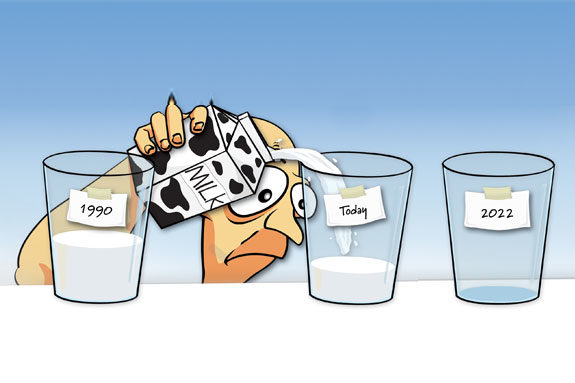Fluid milk sales continue to decline. Recently released USDA numbers show 2011 fluid milk sales at 53.2 billion lbs. Back in 1990, the number was around 54.8 billion lbs., nearly a 3 percent decline. Yet, during this period of time the U.S. added 20 percent more potential milk drinkers. Per-capita consumption of fluid milk has dropped from 220 lbs. in 1990 to less than 178 lbs. today, and the numbers continue to worsen. Through the first five months of 2012, the USDA reports fluid sales are down 2.5 percent.
These numbers are not new to most in the dairy industry. They have been written and talked about. However, it seems the dairy industry has failed to make any significant response to turning fluid sales around. Do we fully understand the economic impact of declining fluid milk sales?
How much does it cost?
If fluid milk per-capita consumption still remained at 220 lbs. (like it was in 1990), more than an additional 12 billion lbs. of fluid milk would be sold this year. To put this in perspective, this is almost the amount of milk produced last year by the nation’s fourth-largest milk- producing state, New York – or about one-half the milk equivalent of U.S. dairy exports. What does this means to dairy farmers in dollars?
Using a conservative fluid differential ($2.50 per cwt) and no over-order premium, it is at least $300 million annually in direct economic benefits.
More economically significant are the indirect benefits. There would be 12 billion lbs. of milk not readily available to the cheese plant or dryer. This could lead to higher prices for milk going into manufacturing plants. More fluid milk sales would help reduce the closing of fluid processing plants due to a declining market.
For example, in the past 12 years, 19 fluid milk plants were closed in the Southeast. Today, the Southeast has 30 percent fewer fluid milk plants than in 2000. Consider the economic impact not only on dairy farmers but on the local communities resulting from this trend.
Having been involved in closing a fluid milk plant, I know first-hand the impact, especially on former employees who were working at the now-closed plant. Dairy economists haven’t put a dollar number on these indirect benefits, but my guess is that it would be several times greater than the $300 million of direct benefits.
In areas of the country such as the Southeast, where fluid milk plants are the only viable milk market, there is a growing competitive situation. As fluid milk sales decline, there is less milk needed. Dairy farmers or their cooperatives lower premiums to gain market access to fluid milk plants.
The fluid milk sales “pie” is getting smaller. Both fluid processors and dairy farmers are slicing up a smaller pie. Increasing fluid milk sales makes the “pie” bigger and provides opportunities for higher milk prices, not lower. Some may think this only impacts dairy farmers marketing milk to fluid plants, but the milk price in one area of the country eventually impacts milk prices in other areas of the country.
Why are people drinking less milk?
The marketing and promotion experts provide many reasons, including fewer meals eaten at home, an aging population and competition from other beverages.
Knowing the reasons for declining milk sales may be helpful, but the focus needs to be not just on why sales are declining, but ways to increase sales. If the current rate of decline in per-capita fluid milk consumption continues, in 10 years the per-capita consumption could be about 150 lbs. or only 17.5 gallons per person. I am confident the dairy industry has the people and financial resources to reverse the trend; it just needs to be made a higher priority.
Suggestions for improvement
As a starting point, let me offer three suggestions to place greater focus on increasing fluid milk sales.
1. Dairy farmers must better understand the economic impact of fluid milk sales to their milk check. When I started in the dairy industry, many fluid milk plants were regulated as “individual handler” pools. Under such a pool, a dairy farmer’s milk price was based on the fluid milk sales of that plant the farmer sold milk to.
A dairy farmer selling milk to a plant with a high Class I utilization was able to receive a higher farm milk price than a farmer selling milk to a plant with a lower utilization. Under an individual handler pool, a dairy farmer knew each month the direct economic impact of fluid milk sales.
I can recall one instance, back in the 1970s, when a plant was losing sales. The plant manager went to his producers and asked them to give the plant $0.50 per cwt for advertising to help increase sales.
The producers agreed to do so for a few months: Sales went up and their milk check went up. Today’s market- wide pooling, low-fluid utilizations in most orders and cooperative pooling makes it more difficult for dairy farmers to see the impact of lower fluid milk sales in their milk checks.
Granted, the industry is not likely to return to individual handler pools. Nor are dairy farmers likely to put up $0.50 per cwt for marketing. But we must do a better job of communicating the economic importance of fluid milk sales to dairy farmers.
Whether in a low-fluid or high-fluid utilization market, fluid milk sales impact all dairy farmers’ milk checks. If dairy farmers better understand how declining fluid milk sales are lowering their milk checks, I would expect to see them use their persuasive powers to encourage or insist their dairy cooperative and promotion leaders make increasing fluid milk sales a priority.
2. Do current fluid milk promotion efforts need “reinventing”? The mandatory fluid processor promotion assessment of $.20 per cwt or about 1.75 cents per gallon generates around $100 million per year. The mandatory producer assessment of $0.15 per cwt produces about $285 million per year.
The 2010 Dairy Management, Inc. (DMI) annual report showed an annual budget of $201.6 million (not all of the mandatory producer promotion assessment is in the DMI budget) with $25.2 million designated to spend on milk promotion efforts (assume this is for fluid).
This is a significant amount of money invested by both fluid processors and dairy farmers. Studies tell us promotion dollars are a good investment and that fluid sales would be lower without these promotion programs.
However, consumption of fluid milk continues to decline at almost 1 quart per capita each year. The dairy industry cannot continue to do the same thing over and over again and expect different results. Maybe it is time to “re-invent” how the millions of fluid promotion dollars are invested.
3. Can the conventional fluid industry learn something from organic milk and soy beverages? Organic fluid milk sales continue to grow, up 2.6 percent the first five months of this year. In articles about Dean Foods spinning off its organic and soy units, the point is made these products are much more profitable than conventional milk.
For example, a Wall Street Journal article about the spin-off reported that organic and soy were 18 percent of Dean’s revenue during the recent quarter but nearly 40 percent of operating income. Organic and soy are doing something right – maybe conventional fluid milk can learn from them.
Let’s not give up on fluid milk sales – nature’s most nearly perfect food. PD
Covington is a retired dairy cooperative CEO and now does some farming, consulting, writing and public speaking.

Calvin Covington
Retired dairy co-op CEO and consultant






